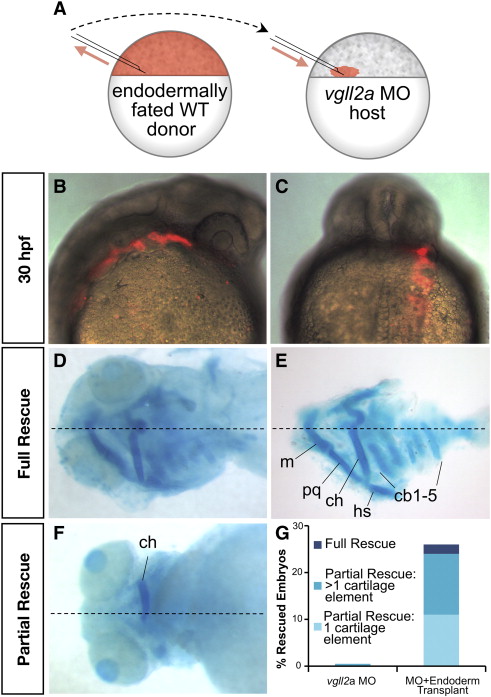Fig. 6
Expression of vgll2a in the pharyngeal endoderm is sufficient for facial cartilage development. Schematic representation of transplantation performed with endodermally fated wildtype vgll2 expressing (WT) cells (A). To create mosaic embryos that express vgll2a within the pharyngeal endoderm but are otherwise Vgll2a knockdown in all other cells, donor embryos were injected at the single-cell stage with cas/sox32 mRNA to fate these embryos to become endoderm along with a rhodamine-dextran tracer. At blastoderm stage, cells were transplanted from the margin of these endodermally fated donor embryos to the margin of vgll2a morphant embryos (A). In lateral (B,) and dorsoposterior (C) views of a representative mosaic embryo at 30 hpf following transplantation, these cells appear red by fluorescent microscopy and often contribute to one side of the pharyngeal endoderm. In ventral views at 5 dpf, alcian blue staining reveals that pharyngeal cartilage development is completely (wholemount, D; and dissected, E) or partially (wholemount,F) rescued in some of these embryos. Quantification of number vgll2a morphant embryos that exhibited rescue upon introduction of endoderm from embryos expressing vgll2a (G). Rescue was scored as rescue of one cartilage element, rescue of more than one cartilage element, or rescue of all cartilage elements (full rescue) relative to morphants and expressed as a percent of the total number of mosaic embryos analyzed (G, n = 46). 26% of endoderm transplants showed partial or full rescue. Dotted lines mark the approximate midline. cb, ceratobranchial; ch, ceratohyal; hs, hyosymplectic; m, Meckel′s cartilage; pq, palatoquadrate. Anterior is to the right in B and to the left in D-F.
Reprinted from Developmental Biology, 357(1), Johnson, C.W., Hernandez-Lagunas, L., Feng, W., Melvin, V.S., Williams, T., and Artinger, K.B., Vgll2a is required for neural crest cell survival during zebrafish craniofacial development, 269-81, Copyright (2011) with permission from Elsevier. Full text @ Dev. Biol.

